CONNECTION
Caring Hearts
Individuals
thrive at day center




thrive at day center



By Shirley Bloomfield, CEO NTCA–The Rural Broadband Association
NTCA members create broadband networks so fast and reliable that it’s easy to take for granted the effort and expertise needed to bring these services to homes and businesses. These professionals do amazing work, particularly when considering the intricate, multistep journey to build, expand and maintain a network.
It begins with detailed research and careful planning. The broadband provider must learn exactly how many homes and businesses might want service, as well as the challenges posed by the landscape. Then, a thorough review of the numbers determines if the project makes financial sense. It’s a puzzle where the pieces are population density, infrastructure costs and potential demand for the service.
Then there’s the engineering—design, build and inspect. Detailed maps identify routes for cables, permitting, environmental regulations and access to land. Some of these projects can take two to four years from the first engineering drawing to the first connection.
The work doesn’t stop when the network goes live. These networks require maintenance, technology upgrades and customer support.
These networks are lifelines connecting rural communities to telehealth, education, remote work and cutting-edge technologies. With the help of service providers like yours, we’re building broadband to last and ensuring no community gets left behind in our increasingly digital world.
To learn more, check out the Foundation for Rural Service and JSI’s latest report, “Delivering Broadband From Beginning to ‘End,’” at frs.org/deliveringbroadband-beginning-end.

When you need information fast, a quick check of Google is often the first stop. In fact, some people find it easier to search online for everything, including the addresses for a specific website like a bank, trusted repair service or health care provider.
Unfortunately, scammers know this, too, so they sometimes create bogus sites with addresses confusingly close to the real thing.
Google is aware of this trend, and it touts advanced systems that keep users’ search results 99% spam-free. The company also offers a few tips for closing the final security weaknesses.
• Pay close attention to the URL—the specific web address—before clicking any unfamiliar link. Typically, in an email, hovering the cursor over the address will show the complete link. Don’t click the link if it looks suspicious.
• The three dots next to the search results in Google can be used to find more details about the webpage, store or business you’re considering. You can find clues indicating if the site is legitimate before clicking the link.
• When you’re looking for official resources, watch out for unusual address formatting. For example, there’s typically only one correct customer service number for a larger company. But not all businesses have customer service numbers, and searching for them requires you to be mindful. Watch for strange formatting in the website address, including unexpected symbols or emojis.

Story by BRANDI DIXON
Hannah Dasher is a blast of classic country and rock ’n’ roll paired with social media influencer. Stepping into the home she calls “Honky-Tonk Graceland” and features on her social media is, as Hannah says, like going back in time to “your meemaw’s house.”
“Avocado green canisters, gold salt and pepper shakers, brass pots. I love my retro kitchen, and I love that the fans feel right at home,” she says, adding that she enjoys entertaining.
Music and songwriting are Hannah’s first loves. “I was rehearsing my acceptance speech for best new female vocalist of the year in my mirror at age 10,” she says. “I grew up listening to ’90s country radio, and knew I wanted to be an entertainer.”
Hannah pursued music professionally, taking her big hair and a heaping helping of Southern charm to Nashville, Tennessee. She started out writing songs for other artists, getting some big accolades thanks to collaborations with Brad
Paisley, Lainey Wilson and Ian Munsick, to name a few. She continued performing whenever she had the chance.
In 2020 during the pandemic, Hannah found herself stuck. “All the stages shut down, and I needed a stage,” she says. “Talking with some friends I learned a lot of girls my age couldn’t cook, so I stumbled into the world of social media, and it was the perfect storm.”
Hannah took to TikTok to share her
family’s beloved recipes and a few of her own, all while sprinkling in a bit of her signature rockin’ country flavor. The recipe produced the now-viral Stand By Your Pan social media accounts. More than 1.5 million followers join Hannah daily in her retro kitchen.
“I love that this brought country and noncountry music fans together,” she says. “It’s hard to pigeonhole into just one world, and I’m glad that I can be this representative of the past and the future via a semicelebrity chef.”
When Hannah Dasher isn’t cranking out content, she’s picking up a guitar and writing music.
“God always sends it from the left side of the sky and out of my mouth,” she says of her process. “Sometimes it’s melody and lyrics simultaneously, but you just never know, and you always have to be looking for it.”
Hannah is on the road this year with her band on The Wanted Tour, featuring stops across the United States, the United Kingdom and Sweden. She encourages fans to spread the word and come see her and her “boys.”

There’s something magical when technology becomes so advanced that it simply works, without fuss or the need for advanced skills. Most likely your smartphone is a great example, particularly whatever app you prefer for photos. Looking for an image of your cat or dog, a mountain or a beach? Just ask and the search will likely provide shockingly good results.

CHARLIE BORING CEO
That app simply does the job, and our internet service is much the same—it simply works. It’s fast, reliable and resilient. Thanks to the long-term investments to create a fiber optic network supported by a team of local professionals, we can provide services that unlock the online world. If you consider internet access essential, there’s no better option.
Whether you’re working from home, attending virtual classes or binge-watching your favorite shows, fiber makes sure everything runs smoothly. Do you have multiple devices online at once, rely on video calls or enjoy challenging online games? No problem. The performance is there whenever you need it.
It’s important to remember not all technologies have the same benefit. They may work, but not as well as fiber. With those other systems, storms might block signals or otherwise create interruptions. However, compared with other technologies, our fiber network is designed to not only stay online more reliably but also bounce back more quickly if there is an outage.
Not every community gets to enjoy this type of internet service. We designed our fiber network for today with features capable of handling future online tools and resources. Considering how quickly technology is advancing, an adaptable network is vital for our community to stay competitive in an increasingly online world.
After all, high-speed internet is more than a nice-to-have luxury. From telehealth services to online education, fiber optic networks give us access to essential resources that fundamentally improve our quality of life. Similarly, reliable, fast internet energizes our economy. From established area businesses to new entrepreneurs, the internet provides the tools needed to compete.
We’re committed to bringing these benefits to every corner of our community. And please remember, BTC Fiber is about more than the physical network. The dedicated professionals making up our team live here, believe in our area’s future and are committed to providing unparalleled support.
So, let’s celebrate the progress we’ve made and look forward to a future where everyone can enjoy the advantages of cutting-edge technology. Our goal is to ensure no one is left behind and that everyone has access to the opportunities high-speed internet provides.
Thank you for your continued support and trust. Together, we’re building a brighter, more connected future.
Connection is a bimonthly magazine published by BTC Fiber, ©2025. It is distributed without charge to all customers of the company.

is a member-owned cooperative dedicated to delivering advanced telecommunications technology to the people of Bledsoe and Sequatchie counties and portions of Van Buren, Rhea, Cumberland and Hamilton counties.
BTC Fiber P.O. Box 609
Pikeville, TN 37367
423-447-2121
423-949-2121
Email: customer service@bledsoe.net
BOARD OF DIRECTORS
John Lee Downey, President
James Condra, Vice President
Sandy Burnett, Secretary/Treasurer
Lamar Johnson
Marvin Price
Brian Reece
Richard Smith
Produced for BTC Fiber by:
On the Cover:

Caring Hearts day center offers a safe, fun place for Preston Cates and other individuals with disabilities to spend the day while their caregivers work or run errands.
See story Page 8.
We love hearing from our members, especially when they share positive experiences with BTC Fiber’s service and staff.
Recently, there was a call from a Beaver Hill resident who wants to be a customer when fiber is available at her address. She spoke with three customer service representatives, as well as lineworkers. She said everyone was very professional, knowledgeable and willing to help in any way they could. Their support gave the woman and her husband confidence that BTC Fiber will not only be their future service provider but will also bring reliable, friendly support.
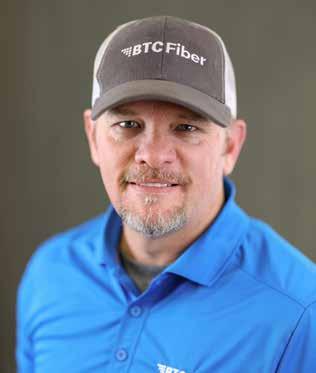
BTC Fiber recently sent PJ Johnson and Austin Mercer to the Young Leaders Conference, an event sponsored by the Tennessee Council of Cooperatives.
The annual conference gives cooperatives across the state the opportunity to educate young leaders about the cooperative business model’s benefits. TCC works hard to build a foundation of appreciation and support for existing cooperatives among conference participants. The Annual Young Leaders Conference is a combined effort of the TCC and the Tennessee Farm Bureau Young Farmers and Ranchers.
Similarly, F. Hankins called to praise one of our team members. “Brian Fann was wonderful when he came to set up my MainStreet Messenger phone. He answered all my questions and concerns that I had. It made me feel good to see how much my phone company cares. I am impressed with the service I was provided.”
Also, Kelsey H. shared her praise for Jillian Barker. “I have never felt so heard by a company. Jillian listened to all my concerns and questions and made sure that all my concerns were completely resolved,” she says.
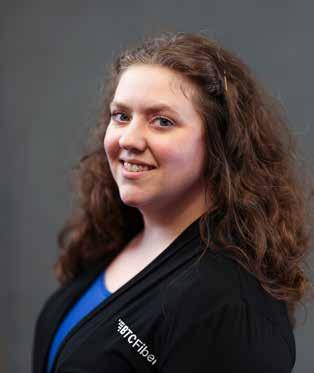













BTC will be closed Monday, May 26, in honor of Memorial Day. Please join us in paying tribute to the men and women who gave their lives in service to their country.
Military personnel will offer vision, dental and basic medical treatment to patients ages 3 and up at no charge July 11-21 at Rhea County Middle School and Bledsoe County High School. There is no income limit or proof-of-residency requirement. No ID is needed. More information will be released closer to the dates at Healthy Tennessee on Facebook.
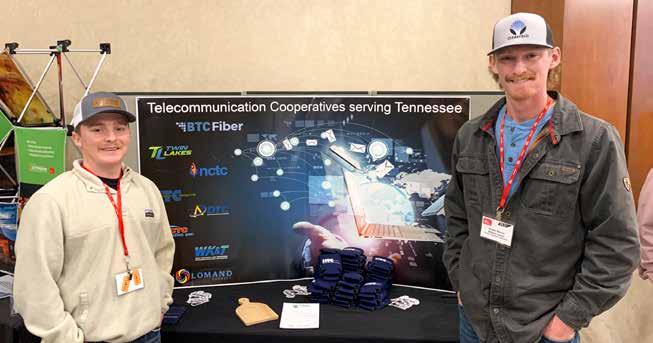


Story by JOHN CLAYTON
Ric Sisler admits he misses the annual spring-to-fall marathon of a baseball season. “When it’s in your blood, it doesn’t matter what you’re doing. You’re always going to be pulled toward that industry, and I’m
WHAT’S IN A NAME?
certainly no exception,” he says. “Going to the ballpark, the camaraderie and being around the yard was just a thrill for me.
“I certainly don’t miss tarp pulls and some of those types of things,”
Marketers and merchandisers will say quite a lot. Creative—some may say outlandish—nicknames, mascots and logos are part of the landscape of minor league baseball. Here are a few of our favorites:
Florida: The Fort Myers Mighty Mussels—The nickname is more about seafood than sinew.
Alabama: Rocket City Trash Pandas—It pairs Huntsville’s role in the space industry with a cute raccoon reference.
Georgia: Augusta GreenJackets—The GreenJackets mascot is
Road trip to baseball’s most entertaining destinations
he says with a laugh, referring to the back-breaking work of getting protective tarps on and off the diamond during rainy weather.
The national pastime is most certainly in Ric’s blood. He played for three
akin to a yellow jacket, but the reference is to Augusta’s long history with The Masters golf tournament, which awards the winner a green jacket.
North Carolina: Kannapolis Cannon Ballers—The alliteration is nice for the team once known as the Intimidators after the late NASCAR star and Kannapolis native Dale Earnhardt Sr., who was then part-owner of the team. The Cannon Ballers mascot, Boomer, has an uncanny resemblance to Earnhardt.
Kentucky: Bowling Green Hot Rods—The nickname gives the team a link to the nearby National Corvette Museum.

seasons in the New York Yankees minor league system before running several minor league organizations as a front office executive and as vice president/ general manager of the independent South Coast League based in Georgia. His father, Dick Sisler, was a Major League Baseball manager and All-Star player, and his grandfather, George Sisler, is enshrined in the National Baseball Hall of Fame.
Ric, who is still involved in athletics as director of corporate sponsorships at Western Carolina University, says many fans of the game come back season after season.
“Minor league baseball has been part of the fabric of our society in a lot of smaller towns,” he says. “It was kind of a binding agent for folks to come watch baseball with their friends and neighbors and just have a wholesome time.”
While the minor leagues are about family fun and community pride to many fans, the game is a balance of business and player development for the teams and their MLB affiliates. The minors have long relied on fan-friendly, creative promotions and player interactions to sell tickets, and all of that comes with an affordable price tag.
“I think people have always gone to minor league games because it’s
affordable,” Ric says. “You had great entertainment and could see some potential big-league players there at

an affordable price. You’re very close to the field and close to the players. It was a different setting from the Major League parks. I don’t want to see that change.”
Planning a trip this summer––or maybe even a baseball pilgrimage? There’s a game, sports history and tradition, as well as a bunch of fun waiting for you.
Some of the oldest ballparks in the country are in the Southeast, and three of them are on the National Register of Historic Places.
That list includes Birmingham, Alabama’s Rickwood Field, which is the nation’s oldest professional baseball park still with its original structure. Opened in 1910, two years before Boston’s Fenway Park, Rickwood was home to the Negro Leagues’ Birmingham Black Barons.
The double-A Birmingham Barons play an annual ceremonial game at Rickwood, and Major League Baseball hosted a game between the St. Louis Cardinals and San Francisco Giants at the venerable ballpark last season, a 6-5 Cardinals victory.
Jackie Robinson Ballpark in Daytona Beach, Florida, was the first ballpark to allow the Brooklyn Dodgers’ African American prospect whose name now graces the stadium to play with white players in the segregated South in 1946. The park dates to 1914 and was originally named Daytona City Island Ballpark.
Spartanburg, South Carolina’s Duncan Park was constructed in 1926 and was home to minor league baseball almost continually until 1994. It was also home to the Spartanburg Sluggers, a Negro League minors team from 1928-52. An estimated 21,000 spectators reportedly crowded in and around the ballpark to attend Game 5 of the 1938 American Legion World Series between Spartanburg and Los Angeles.
The 3,000-seat stadium is currently Spartanburg High School’s home field. The city of Spartanburg is building a new stadium for the Hub City Spartanburgers of the South Atlantic League. The city is the new home of the former Down East Wood Ducks of Kinston, North Carolina.

Story by MELANIE JONES
As Jaymes Booth catches the bus to Caring Hearts, he says he’s going to work. When he arrives, he may greet people, help in the kitchen, set up for lunch, sweep the floors or take out the garbage. Some days, he even wears a uniform. “He thinks he’s in charge,” his mother, Vanessa Booth, says.
Jaymes, 35, has cognitive disabilities. Since graduating high school at 22, he has relied on Caring Hearts, a center where individuals whose disabilities prevent them from being left home alone can spend the day making friends and taking part in fun and engaging activities.
Jaymes says he’s going to his job, and no one has told him otherwise. Vanessa says it gives him purpose. “If Jaymes didn’t have the disabilities he has, I think he would work in a hospital or care for the elderly,” she says. “He’s really right where he wants to be.”
Caring Hearts serves more than disabled younger adults. It also helps seniors with Alzheimer’s disease and other types of dementia.
When she started the center, Caring Hearts founder Frankie Moughrabi thought most of her clients would be elderly people because the population with dementia is growing. Instead, she found that many—if not the majority—

of the folks Caring Hearts serves are young adults who aged out of the special education system.
“We have a mixture right now of elderly and younger folks, and it’s really such a good dynamic because the younger ones see the older ones are like grandparents,” Frankie says. “And the older ones love kids and being around younger people, so they see them as like grandkids, so it’s all really become like family,”

And that’s part of the appeal for Vanessa and for Jaymes, who likes to spend time with the older guests.
“They’ve just been a godsend all the
way around,” Vanessa says of the center. Caring Hearts provides Jaymes with opportunities to socialize. It gives him purpose and makes him happy. And it provides his mother with peace of mind so she can go to work and know he is safe, having fun and learning.
The center has a computer station for guests and an area set up like a living room where visitors can watch movies. All the center’s computers have internet access through BTC Fiber. There’s an area where they work on crafts or just sit and
by



do crossword puzzles. “Whatever they want to do, they can do,” Frankie says. The activities director also organizes programs for the guests. “On nice days, we have a nice park behind us, so she’ll take them outside to the park. They love that,” Frankie says. “She always has all kinds of neat things that she does with them.”
Jaymes has been going to Caring Hearts almost as long as it’s been open, and
Vanessa is glad there was no gap between his leaving school and starting at the center. “He made new friends,” she says. After a bit, some of his school classmates also enrolled.
Vanessa and Frankie say there are common misconceptions about adult day centers. Many people think of them as places for older folks who may not be highly active, but they are for younger people
with disabilities, too, and both groups can be quite active.
“We don’t have anything other than Caring Hearts,” Vanessa says of families with adult children who have aged out of the school system.
Most of the families at Caring Hearts rely on Tennessee Choices for financial support. Typically, health insurance will not cover nonmedical programs, and for those who self-pay, the center offers a sliding scale based on income.
“We said when we opened, we would not turn anyone away that needed us,” Frankie says. “There’s not anything else like this in the area, so we wouldn’t turn anybody away for financial reasons. If they don’t qualify for Choices, we’ll sit down with the family and figure out a reasonable amount that they can afford.”
In fact, the initial visit is free. At first, the client often doesn’t understand what the center is. “A lot of times, they’re very hesitant about coming,” Frankie says. But after they’ve enjoyed themselves during their first visit they want to come back.
The center will accept almost anyone with a disability who is mobile, Frankie says. It cannot accept people who are bedbound, but it does have clients who use wheelchairs. The staff can help with feeding or bathroom visits if necessary.
“Anyone can utilize our services at any point that they need us, even if they just need us for a couple of hours one day a month or so,” Frankie says. “We have had people that just used us when the husband had Alzheimer’s and the wife had to go to the doctor. It’s hard to take them to the doctor, so she would just bring him down then or when she was going shopping. Just call us and let us know that morning.”
15227 Rankin Ave., Dunlap
423-949-8573
caringheartstn.com
Caring Hearts is on Facebook
Caring Hearts also offers in-home, nonmedical care.


Story by SARA DIAMOND PATTERSON
Catching lightning bugs in a Mason jar with holes punched in the lid is a summer ritual for kids across the country. Watching their light show together is often a time for families to slow down, which is what Lynn Frierson Faust’s family began doing in the Great Smoky Mountains during the 1960s.
They marveled for years at the unique light display, as the flying beetles blinked on and off at the same time for several hours after dark. When Lynn heard the August 1991 edition of Science News magazine featured an article on fireflies that blink in unison, she figured she would finally find out why and how they made their magic.
“I remember thinking, ‘Oh cool, a lightning bug feature. It’ll talk about our light show.’ Only it didn’t mention one thing,” she says. In fact,
the authors said the Western Hemisphere had no species of fireflies that blinked synchronously.
Lynn let them know they were mistaken and invited them to come to the Smokies to see the show for themselves. The scientists did and agreed Lynn was right, lighting the way for her life’s work.
‘JUST SO DARN FUN’
As “The Lightning Bug Lady,” Lynn is internationally known for her research on the ecology and habits of the more than 125 species of U.S. fireflies, helping
HOW: Fireflies produce their magical flashes through bioluminescence, a chemical reaction.
WHY: Each of the more than 125 species of fireflies in the United States—2,000 worldwide—has a unique signature flash pattern the males use to attract females of their specific type.
WHERE: Everywhere. Many Western species do not flash or fly, but they’re out there.
WHEN: Warm summer nights.

Pesticides and habitat reduction have taken a toll on firefly populations. Maintaining a “wild” area of your yard with a little water, native vegetation and undisturbed soil will make your home more firefly friendly. But the easiest way to help is simply by turning out the lights during their active period. Visit xerces.org or firefly.org for more tips.

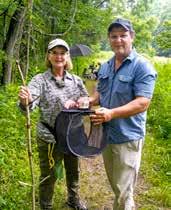
A BBC crew takes a break from filming in 2019. Naturalist Lynn Frierson Faust examines equipment she and Mark Zloba, ecological manager at the Edge of Appalachia, use to gather fireflies at the preserve outside of Cincinnati.
to raise awareness of their unique life cycles and importance within ecosystems.
She scrambles to 14 states each year to catch them emerging during their eight-week active season, usually early June to late July. For 18 years, she has been the worldwide go-to on the subject, serving as on-site scientific consultant for BBC Earth, Discovery, National Geographic and other international film crews. Lynn’s 2017 book, “Fireflies, Glow-worms, and Lightning Bugs,” was the first-ever comprehensive firefly field guide and shared the results of her nearly three decades of research on behalf of museums, universities, state and national parks and nature centers.
“I’m not a scientist per se, but I’ve done the research, a whole lot of research,” she says. “I’m just a regular person obsessed with these and fortunate to have the time and a little knowledge to build on.”
Throughout history, fireflies have symbolized hope and mystery, serving as transient reminders that life is fleeting. In some cultures, people see them as their lost ancestors, a sacred connection between the earthly and spiritual worlds.
When she began, Lynn didn’t have much research to start with. “There were just a bunch of dusty old scientific papers, but that’s about it,” she says. “There’s just not been that much research done on them since they aren’t harmful or helpful to people or crops.”
They are, however, a great indicator species for the health of ecosystems. “When they disappear, we have to know why and where to look.” And
No matter where you are, you don’t have to go far to find the magic. You can look for lightning bugs anywhere from your backyard to wildlife management areas or wooded parks, avoiding light pollution and areas that spray for mosquitos.
The Southeast offers the most variety of firefly species. “Generally speaking—and this holds true for almost all living things—as you go south closer toward the equator, you get a greater diversity of species but maybe fewer numbers,” firefly expert Lynn Frierson Faust says. “Whereas when you go north in latitude, you get greater numbers but fewer species.”
The Photinus carolinus species in the Great Smoky Mountains National Park of Tennessee and North Carolina are known for their synchronous flashes. You can see them put on a similar show at South Carolina’s Congaree National Park. Thousands of these fireflies emit between five to eight flashes of light all at once followed by eight to 10 seconds of darkness.
Their light shows have become so popular, each year more than 20,000 people enter a lottery drawing at each park for viewing spots during the two-week active period, usually in early June depending on temperatures and soil moisture.
Lynn says they will always serve as a nostalgic reminder of days gone by.
“Lightning bugs are fantastic ambassadors leading people back into nature and to a better understanding of the connectedness of it all,” she says. “Plus, they’re just so darn fun.”
Officially known as Lampyridae, worldwide fireflies are called blinkies, glowflies, moon bugs, peeneywallies, blinkin’ bees, hoturu, fire beetles and candle flies. Here at home, “lightning bug” is more common in the South and Midwest, while “firefly” is typically heard in the West and large cities in the East. Some researchers attribute the differences to weather. While lightning is most active in the South and Midwest, the West sees the most wildfires.
Story by MELANIE JONES
When Larry Taylor, 85, found a Lionel model train set under the Christmas tree at age 9, he was hooked. As an adult, that fascination only grew as he traveled on some classic rail lines. Getting his then 2-year-old grandson model trains cemented his plans.
While he was still working full time, Larry promised himself he’d build a railroad after he retired. And that’s exactly what he did, with a little help from his friends.
They built Eagle Point Railroad, which is known as a live steam railroad––one-eighth the size of the real thing. While most such railroads are built in public parks, this one is built on a mountain in Dunlap, with 5 miles of tracks running through the trees. It mimics a real railroad with trestles, bridges, tunnels, miniature towns and industries. It’s even big enough to carry passengers.
But not everyone can access Eagle Point. For the most part, it’s run by the Chattanooga Society of Model Engineers and welcomes members and their guests. Some groups, like scout troops, can make appointments to visit the railroad. Eagle Point is so popular, it has welcomed guests from as far away as England and New Zealand.
The land itself is in a trust in the name of Larry’s wife, Dianne, so it will live beyond him. “I still play with trains,” Larry says, but his daughter, Amanda Murphy, manages the finances and member contracts.
As an electrical engineer by trade, Larry was uniquely qualified to build the railroad, which he constructed to meet actual railroad standards. “The handbook that I used was ‘Building Railroads,’ and it was published in 1953,” Larry says. “It showed different construction techniques, so I took that and just scaled it down to one-eighth.”
Very little of the railroad is accessible by vehicle––except the trains. In fact, Larry and his friends had to use trains to access areas to build the railroad and haul in supplies. “As you extend the track out, you took the materials out there on the train and continued just extending it, and that’s how we built the whole railroad,” Larry says.
Larry and his friends took care to be as sensitive as possible to the environment. “We followed the contours of the land. We leave the trees,” he says. “One of the hazards we have is, in stormy
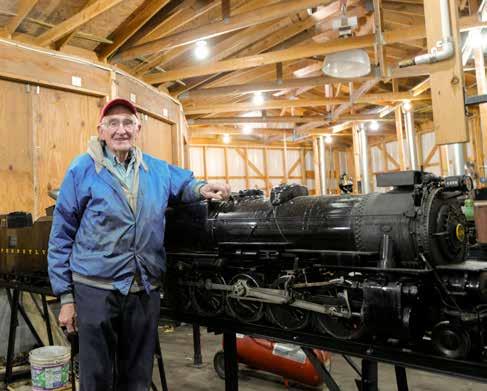
weather, trees coming down on the track. That’s not much of a problem except when some of the big trees fall.” On one occasion a huge tree fell and destroyed a bridge. “We had to rebuild the bridge, but that’s living in nature.”
A few trees can’t stop the railroad, and neither can snow. One of the engines is equipped with a snowplow to keep the railroad open. “It’s like the real railroads,” Larry says. “A lot of times, highways get closed, but the railroads keep running.”
When Eagle Point Railroad started, most of the members used steam engines that burned coal, but in the past 10 years or so, more have opted for diesel engines. Larry has three models of diesel engines built by people in the hobby.
Because the trains can operate in most any weather, Larry says there’s somebody at the railroad most of the year. The only thing that keeps them away is extreme cold.
That doesn’t stop them from pursuing their hobby, though. Live steam railroads exist across the world. Members of the Chattanooga Society of Model Engineers often visit railroads in Florida during the winter. Florida hobbyists will come to Eagle Point when it gets too hot there.
Because the railroad is laid out like a real one, running through miniature towns and industries, there is always plenty to do.
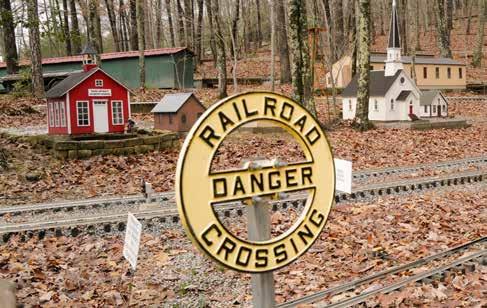
“During the year, we’ll schedule operating sessions where we operate the model railroad like a real railroad,” Larry says. And because it is a signal track, they can safely operate trains going in both directions. It takes about an hour and 15 to 20 minutes to travel the 5-mile railroad, depending on traffic.
While some may refer to the trains as miniature, they’re certainly not small. Some of the smaller locomotives are 300 to 400 pounds, while midsized ones are typically 800 to 900 pounds. “Then some of the large ones are up to 2,000 pounds each,” Larry says. “One of our members calls it ‘the hernia gauge.’”
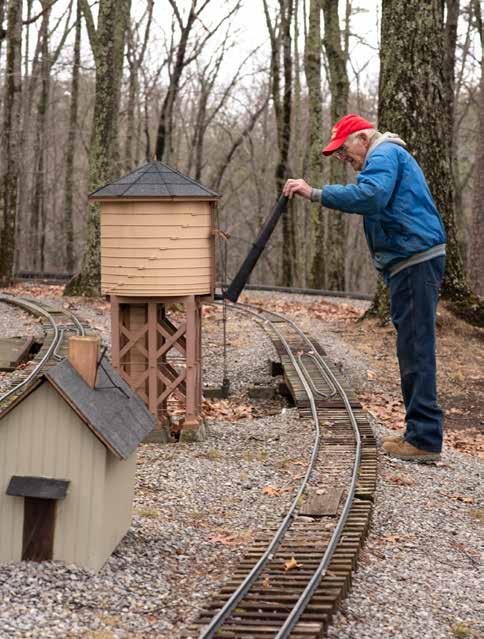
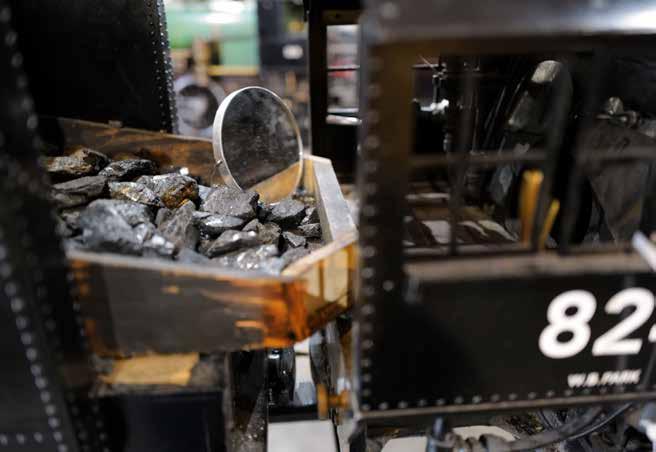
The trains aren’t cheap, either. “You can build your own fairly inexpensively,” Larry says. But a commercially built steam locomotive can run $30,000 to $40,000. Diesels typically cost about $15,000 to $20,000.
Running a live steam railroad can take serious money and skilled engineering, but in the end, it’s all about fun. “It’s just big kids playing with big toys,” Larry says.
csme-eprr.com
Eagle Point Railroad is on Facebook.

Many say munching on piping-hot, crispy fried chicken is a joy like no other. Whether it’s juicy white meat from the breast or the wings or the deep, engaging flavors of the dark meat found in thighs and legs, when it comes to fried chicken, most everyone has a preference. But there are a few things that good pieces of fried chicken have in common—the skin must stay on, and it must be crispy.
That’s not too much to ask, but it’s something that many cooks cannot achieve. There’s a knack to it that may take a few extra steps, but the endgame is well worth it.
Serve the chicken alongside a big spoonful of potato salad and finish with a bowl of banana pudding and you have a meal fit for a beautiful summer evening.

Food Editor Anne P.
Braly
is a native of Chattanooga, Tennessee.
Photography by Mark Gilliland
1 (4-pound) chicken, cut into pieces
1 cup whole milk buttermilk
2 cups all-purpose flour for coating
1 teaspoon paprika
1 teaspoon garlic powder
Salt and pepper to taste
2 quarts vegetable oil for frying
Dry chicken with paper towels. Put the flour in a large plastic bag. Let the amount of chicken you are cooking dictate the amount of flour you use. Season the flour with paprika, garlic powder, salt and pepper to taste. Paprika helps to brown the chicken.
Dip chicken pieces in buttermilk then, a few at a time, put them in the bag with the flour, seal the bag and shake to coat well.
Place the coated chicken on a cookie sheet or tray, and cover with a clean dish
towel or waxed paper. Let sit until the flour reaches a paste-like consistency. This step is important to ensure that the skin will be crispy and adhere to the chicken.
Fill a large skillet (cast iron is best) about 1/3 to 1/2 full of vegetable oil. Heat until very hot.
Put in as many chicken pieces as the skillet can hold. Brown the chicken in hot oil on both sides.
When browned, reduce heat and cover the skillet. Let cook for 30 minutes (the chicken will be cooked through but not crispy). Remove cover, raise heat again and continue to fry until crispy. Drain the fried chicken on paper towels. Depending on how much chicken you have, you may have to fry it in a few batches. Keep the finished chicken in a slightly warm oven while preparing the rest.

4 pounds russet potatoes
1-2 tablespoons olive oil
3 tablespoons apple cider vinegar
1 cup mayonnaise
3/4 cup sour cream or full-fat Greek yogurt
1/2 cup cheddar cheese
1 teaspoon kosher salt
1 teaspoon freshly ground black pepper
12 ounces bacon, cooked, cooled and chopped
6 green onions, whites and green parts, chopped
Preheat the oven to 400 F. Place cleaned potatoes on a baking sheet and pierce four to five times with a fork. Lightly coat with olive oil, sprinkle with kosher salt and cook for 50-60 minutes or until easily pierced with a cake tester or skewer. Remove from the oven and let cool for 5 minutes. When cool enough to
8 ounces softened cream cheese
1 (14-ounce) can sweetened condensed milk
2 (3.4-ounce) boxes instant vanilla pudding
2 3/4 cups cold milk

handle, peel the potatoes and cut into 1-inch chunks, discarding the potato skins. The potato flesh may crumble and get shaggy, and that’s OK—transfer it all to a large mixing bowl. While still warm, sprinkle the potatoes with the apple cider vinegar. Set aside for 15-30 minutes or until the potatoes are cooled.
Meanwhile, cook the bacon in a large skillet or in the oven, drain and let cool. Crumble into bite-size pieces.
In a small bowl, mix the mayonnaise and sour cream. Season with the kosher salt and pepper.
When the potatoes are cool, pour the mayonnaise mix over them with the crumbled bacon, green onion and cheddar cheese. Gently fold the ingredients together. Season with more salt and pepper to taste. Refrigerate for 3 hours up to overnight before serving. Store in the refrigerator for up to four days.
8 ounces whipped topping divided 1 (1-pound) package Nutter Butter or other peanut butter sandwich cookies
5-7 ripe bananas, sliced
In a large mixing bowl, beat the softened cream cheese until smooth. Add the condensed milk and mix until there are no lumps.
In a second bowl, mix the pudding mix and milk together until smooth. Pour the pudding into the cream cheese mixture and mix until completely combined. Fold in half of the whipped topping.
Line the bottom of a trifle dish with a layer of Nutter Butter cookies. Add a layer of banana slices on top of the cookies. Spread a layer of the pudding mixture evenly over the bananas. Repeat 1-3 times, depending on the size of your dish. Spread the remaining whipped topping on top of the pudding. Cover and chill for at least 4 hours but overnight is best.
Crush a few Nutter Butters on top of the whipped topping immediately before serving.



Congratulations to all 2025 high school, college and technical school graduates. Enjoy this moment—your future is bright! Everyone at BTC Fiber is excited for your future. TO THE CLASS OF 2025!

